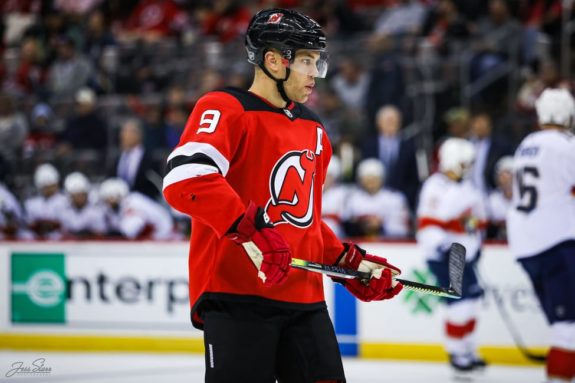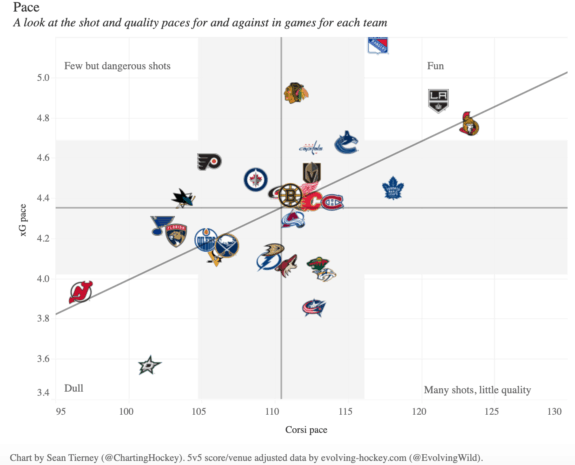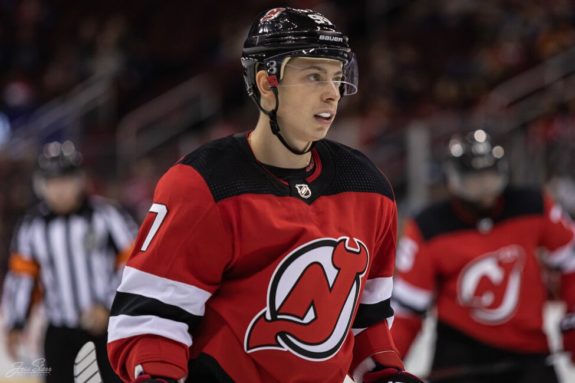The New Jersey Devils have not gotten off to an ideal start to the 2019-20 season. They sit at 2-5-2 through nine games and are making life a lot more difficult than it needs to be. What’s most concerning about the Devils’ start is an offense that’s sputtering and is one of the league’s worst, if not the worst, at five-on-five.
It isn’t for the lack of talent, either, as players like Taylor Hall, Jack Hughes, and Kyle Palmieri know a thing or two about creating offense. So what’s the problem? Head coach John Hynes needs to make serious adjustments to his system of low-event hockey that limits the offensive abilities of players like Hall and Hughes.
The Difference Between Low and High-Event Hockey
Low and high-event hockey are both pretty simple to understand. A team like the Devils, who play low-event games, won’t generate a ton of shot attempts and scoring chances, but they won’t allow many, either. On the opposite end is a team like the Toronto Maple Leafs, who play high-event games, meaning they generate a lot of shot attempts and chances. But the catch here is they’ll allow a fair bit, too.

A team like the Leafs should be playing high-event games because of the talent they possess up front. The Devils don’t quite have the skill-level the Leafs do at forward. But with the likes of Hall, Hughes, Palmieri, and Nico Hischier, it makes little sense to be playing the slow, defense-oriented style they play.
Devils’ Low-Event Hockey Becoming Problematic
There are a lot of things the Devils need to improve to get out of the hole they’ve dug themselves early this season. But what may be plaguing them the most is the rate at which they generate shots and scoring chances. Here’s where their shot attempts per 60 minutes (CF/60), scoring chances per 60 minutes (SCF/60), high-danger chances per 60 minutes (HDCF/60), and expected goals per 60 minutes (xGF/60) at five-on-five rank in the NHL:
- CF/60: 45.16 (last)
- SCF/60: 20.91 (last)
- HDCF/60: 7.26 (last)
- xGF/60: 1.85 (last)
For a team that has players like Hall, Hughes, and Hischier, they should not be ranked dead last in the NHL when it comes to generating shots and chances. Some blame falls on the players for not playing up to their capabilities. But the bigger problem is the team’s system, as the Devils are right there with the Dallas Stars as the dullest teams in the league in terms of shot and quality pace.

It is a small sample size of just nine games this season. But the Devils being dull and struggling to generate offense under Hynes isn’t anything new. They ranked last in CF/60 in 2015-16, 2016-17, and second to last in 2018-19. And even during their run to the playoffs in 2017-18, they finished sixth to last in CF/60.
If we expand things to include xGF/60, the results are much of the same. They ranked last in 2015-16, fourth to last in 2016-17, and ninth to last in 2018-19. The outlier is 2017-18, where they finished with the 15th-best xGF/60 in the league. But the key is that’s an outlier, as there’s more than enough evidence to support the claim the system Hynes is running limits the number of shots and chances generated.
Related: Devils’ Hynes Squarely on the Hot Seat
On the flip side, the Devils have been one of the best shot and chance suppressing teams under Hynes. From 2015-18, they ranked in the top ten in shot attempts, scoring chances, high-danger chances, and expected goals against per 60 minutes. That’s the benefit of low-event hockey, but it’s at the point where they’re sacrificing too much offense for defense. And it’s hampering their ability to be the fast, attacking team Hynes promised when hired as coach in 2015.
Devils’ Roster Not Built for Slow Pace
General manager Ray Shero made sweeping changes to the Devils’ roster this offseason. The first move was drafting Hughes with the first overall pick at the Entry Draft. Hughes is a dynamic center that possesses elite offensive ability, but that runs the risk of being stifled in a system that doesn’t emphasize playing at a high pace.
Another move Shero made that should be giving the Devils an offensive spark was acquiring Nikita Gusev from the Vegas Golden Knights. Gusev had never played in an NHL game before the 2019-20 season, but he had dominated the KHL for a few seasons and was the league’s MVP in 2018-19. Gusev’s defense has been a problem so far, which has limited his minutes, but he was brought in to score and not shut down opponents. And Hynes isn’t doing anyone any favors by having offensively-limited players like Kevin Rooney and John Hayden log more ice time than Gusev.

Aside from the additions of Gusev and Hughes, the Devils already had players who could push the pace. There’s a reason Hall won the Hart Trophy in 2017-18, and he’s one of the best drivers of play in the NHL. But it’ll be hard to get the most out of him in a system that stresses low-event games.
The same is true for Hischier, Palmieri, and Jesper Bratt. Bratt, who produced at a 50-point pace last season, has struggled this season and was even a healthy scratch in their most recent game. However, Hynes hasn’t helped him out by relegating him to 10-11 minutes a night on a line with Rooney as his center, as that’s not the right way to use a player like Bratt, given his skill level.
Related: Devils Smart to Give Hischier Long-Term Extension
Devils’ fans were not expecting a team with the firepower they have to come out and be one of the worst offensive teams in the NHL. Their power play has picked it up after a terrible start, but things are at rock bottom at five-on-five, and that has to change. It’s time they embrace the high-energy, high-event style that many other top teams are playing these days, and they have the roster do it. Anything else, and it’ll be a complete waste of their top players’ talents.
* * *
Advanced stats from Natural Stat Trick